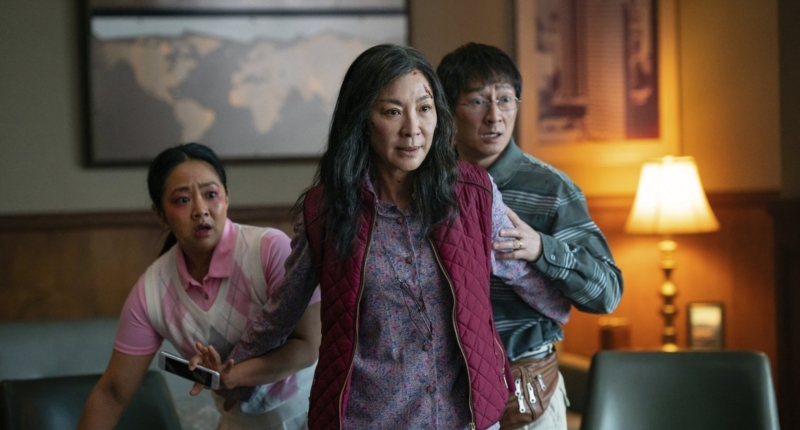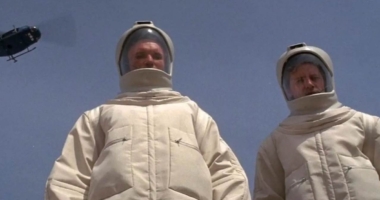The movie “Everything Everywhere All At Once” offers a unique blend of surrealism and philosophy, exploring the themes of existentialism and nihilism. It emphasizes the idea that coming together might be the only way to go against any crisis, as chaos can’t be defeated by causing more chaos. The film’s characters, including Waymond, promote empathy and kindness over toxic masculinity, ultimately reminding viewers to focus on the present moment and appreciate the little things in life. The movie has won numerous awards, including seven Oscars, and has been praised for its innovative use of low-budget visual effects. The story follows Evelyn, a Chinese immigrant woman, as she embarks on a journey through parallel universes to save the multiverse from unlimited madness. Along the way, she embraces a philosophical movement called “Optimistic Nihilism,” which stands for the unbearable lightness of insignificance. The film also features impressive martial arts choreography and references to famous films.
The movie ‘Everything Everywhere All At Once’ is a remarkable independent sci-fi film that has garnered multiple awards from prestigious ceremonies such as SAG, BAFTA, Golden Globes, and the Oscars. It follows the journey of Evelyn Wang, a Chinese immigrant woman, through a chaotic multiverse. The film manages to explore deep concepts like the true nature of things, the reason for being, struggle with nothingness, and infinite realities through the story of Evelyn and her daily life issues.
At the beginning of the film, we get a glimpse of Evelyn’s everyday life routine and her complicated relationships with her family. Her character is overwhelming, making it harder for her to communicate with her husband Waymond and her daughter named “Joy.” Evelyn is going through a tough time, haunted by regrets from her past and feeling like her life is a mess. This is a familiar feeling for many of us, pondering on the choices we made and complaining about missed opportunities.
The movie conveys the message that although we live in a world full of countless possibilities, there is not enough time to experience all of them, and there is no way to reach absolute satisfaction. However, there is always a chance to find happiness and inner peace by accomplishing our goals, enjoying the little things, or appreciating random moments with our loved ones.
In an unexpected twist, Evelyn has to embark on a journey through the parallel universes and “becomes” the alternate versions of herself. Her only trouble before was dealing with domestic matters and confronting tax affairs, but now she is commissioned to save the entire multiverse from unlimited madness. The film takes us beyond our imagination, making us wonder about the possible outcomes of our different decisions.
‘Everything Everywhere All At Once’ is a groundbreaking film that manages to depict the chaos of the multiverse while exploring deep philosophical concepts. It is a must-watch for anyone who enjoys sci-fi and wants to witness a masterpiece of storytelling. The film’s success at multiple award ceremonies is well-deserved and has rightfully earned it a place in cinematic history.
The experimental film “Everything Everywhere” was one of the biggest surprises of the last year, not only reviving the genre but also becoming the highest-grossing movie of A24, a film production company known for arthouse films such as “The Witch,” “Midsommar,” “Uncut Gems,” and “Ex Machina.” Daniel Kwan and Daniel Scheinert, the movie’s directors and writers, brought a unique style of storytelling and innovative cinematography techniques to the table. They creatively represented the bizarre nature of chaos in a humorous way.
One aspect of the film that deserves special attention is its variable visual language. Despite the challenge of illustrating the depth and diversity of the multiverse, the VFX team consisted of only seven people who had learned effects from tutorials on YouTube. The crew used practical effects such as puppets, prosthetics, LED lights, and matte paintings while shooting, with a minimal amount of CGI. They built makeshift studios for scenes that needed multiple settings and combined locations in editing. This retro style approach is highly acclaimed, especially in the era of overused CGI effects.
Throughout the storyline, Evelyn, the protagonist, journeys through various realities that have been elaborately designed, utilizing different color palettes, shutter angles, and lens choices. Fun fact: some of these scenes reference famous films like “2001: A Space Odyssey,” “In The Mood For Love,” “Carol,” and even Pixar’s “Ratatouille.”
The choreography in the film is also noteworthy. Martial arts play an essential role in most of the parts, and the talented actors, Michelle Yeoh and Ke Huy Quan, did most of their own stunts in the fighting scenes. Their absurd yet epic kung fu sequences are worth watching over and over again.
The cast of “Everything Everywhere All At Once,” including Michelle Yeoh, Ke Huy Quan, Stephanie Hsu, and Jamie Lee Curtis, have achieved great success and recognition for their performances in the film. Yeoh and Quan gave inspiring speeches at prize-giving ceremonies, raising hopes for a larger Asian presence in the film industry.
The film dominated major categories at the 95th Oscars, winning seven out of eleven nominations, including best picture, best actress, best director, and best supporting actor. Michelle Yeoh made history as the first Asian woman to win the best leading actress award, while Ke Huy Quan touched guests with his win for best supporting actor after a 20-year hiatus.
“Everything Everywhere All At Once” uses the multiverse as a metaphor to explore the human reaction to cosmic obscurity and the absurdity of being. Evelyn’s character arc reflects the film’s subtext of the unbearable lightness of insignificance and the philosophy of “Optimistic Nihilism.” The film suggests that people attach too much meaning to their regrets, failures, and anxieties, while in the grand scheme of things, none of it matters. Evelyn finds solace in the sweet silence of the void, but still values her people and is willing to do whatever it takes to save them.
In addition to Evelyn’s character, Waymond Wang’s peaceful nature becomes a milestone in the conflict. Waymond rejects toxic masculinity to stand on his empathy and kindness, defining his view of life as a strategy for survival. His character is a refreshing departure from the traditional “power of love and friendship saves the day” trope.
“Everything Everywhere All At Once” is a groundbreaking film that has won numerous awards and accolades, including major categories at the Oscars. Its unique style of storytelling, innovative cinematography techniques, and low-budget visual effects make it a must-watch for sci-fi enthusiasts. The film’s philosophical basis and thematization make it thought-provoking and mind-bending, appealing to audiences seeking a deeper storyline. The film’s success and recognition at major award ceremonies are well-deserved, cementing its place in cinematic history.
The movie “Everything Everywhere All At Once” offers a unique blend of surrealism and philosophy, exploring the themes of existentialism and nihilism. It also emphasizes the idea that coming together might be the only way to go against any crisis, as chaos can’t be defeated by causing more chaos. The film’s characters, including Waymond, promote empathy and kindness over toxic masculinity, ultimately reminding viewers to focus on the present moment and appreciate the little things in life.
Don’t miss interesting posts on Famousbio










